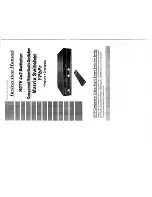
C H A P T E R
34-1
Catalyst 3560 Switch Software Configuration Guide
78-16156-01
34
Configuring Fallback Bridging
This chapter describes how to configure fallback bridging (VLAN bridging) on the Catalyst 3560 switch.
With fallback bridging, you can forward non-IP packets that the switch does not route between VLAN
bridge domains and routed ports.
To use this feature, the switch must be running the enhanced multilayer image (EMI).
Note
For complete syntax and usage information for the commands used in this chapter, refer to the Cisco IOS
Bridging and IBM Networking Command Reference for Release 12.1.
This chapter consists of these sections:
•
Understanding Fallback Bridging, page 34-1
•
Configuring Fallback Bridging, page 34-2
•
Monitoring and Maintaining Fallback Bridging, page 34-10
Understanding Fallback Bridging
With fallback bridging, the switch bridges together two or more VLANs or routed ports, essentially
connecting multiple VLANs within one bridge domain. Fallback bridging forwards traffic that the switch
does not route and forwards traffic belonging to a nonroutable protocol such as DECnet.
A VLAN bridge domain is represented with switch virtual interfaces (SVIs). A set of SVIs and routed
ports (which do not have any VLANs associated with them) can be configured (grouped together) to
form a bridge group. Recall that an SVI represents a VLAN of switch ports as one interface to the routing
or bridging function in the system. You associate only one SVI with a VLAN, and you configure an SVI
for a VLAN only when you want to route between VLANs, to fallback-bridge nonroutable protocols
between VLANs, or to provide IP host connectivity to the switch. A routed port is a physical port that
acts like a port on a router, but it is not connected to a router. A routed port is not associated with a
particular VLAN, does not support VLAN subinterfaces, but behaves like a normal routed port. For more
information about SVIs and routed ports, see
Chapter 10, “Configuring Interface Characteristics.”
A bridge group is an internal organization of network interfaces on a switch. You cannot use bridge
groups to identify traffic switched within the bridge group outside the switch on which they are defined.
Bridge groups on the switch function as distinct bridges; that is, bridged traffic and bridge protocol data
units (BPDUs) are not exchanged between different bridge groups on a switch.
Fallback bridging does not allow the spanning trees from the VLANs being bridged to collapse. Each
VLAN has its own spanning-tree instance and a separate spanning tree, called the VLAN-bridge
spanning tree, which runs on top of the bridge group to prevent loops.
















































